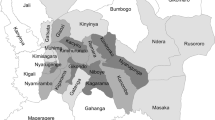Abstract
Taking Nanjing as a case, the paper explains the spatial behavior differences existing in the information technology use among different groups of residents and households, by virtue of analyzing the survey data of urban households in the 11 districts of Nanjing, from the social, spatial, life and other non-technical angles. Also it makes various analyses and evaluation quantitatively and qualitatively on the social and spatial effect of information technology. The results show that the new technology is changing the social spatial behaviors of urban residents. New behavioral spaces of urban family such as telecommuting, email and QQ have begun to emerge. With the help of Internet, the communication scope of families has expanded greatly, and more new forms of publicizing community information have begun to emerge. Telecommunication contact forms have been developing swiftly, and their frequencies of contact have been increasing dramatically.
Similar content being viewed by others
References
Arnulf Grübler, 1998. Technology and Global Change. Cambridge: Cambridge University Press.
Castells M, 1996. The Rise of the Network Society. Oxford: Blackwell Publishing Ltd.
Giuliano Genevieve, 1998. Information technology, work patterns and intra-metropolitan location: A case study. Urban Studies, 35(7): 1077–1095.
Jiang Wei, Yang Dengsong, 2000. Research on character of urban citizen travels in the network information society. Journal of Highway and Transportation Research and Development, 17(4): 41–43. (in Chinese)
Liu Hui, Zhen Feng, Liang Zuoqiang, 2007. Study on features of the residents’activity under the effect of informatization—Taking the Suxichang Area for example. Henan Science, 25(1): 169–172. (in Chinese)
Liu Weidong, 2002. Development of the Internet in China: Spatial characteristics and implications. Geographical Research, 21(3): 347–356. (in Chinese)
Michel J G, 2004. Spatial interaction models of international telecommunication flows. In: Michael F et al. (eds.). Spatially Integrated Social Science. Oxford: Oxford University Press, 409–419.
Mitchell W J, 1999. E-topia: Urban Life, But Not As We Know It. Cambridge: The MIT Press.
Stephen G, Simon M, 1996. Telecommunications and the City: Electronic Space, Urban Places. London: Routledge.
Thrift N, 1996. New urban eras and old technology fears: Reconfiguring the goodwill of electronic thing. Urban Studies, 33(8): 1463–1493.
Yan Xiaopei, 1998. The future trend of urban development. Urban Planning Overseas, 4: 35–40. (in Chinese)
Author information
Authors and Affiliations
Corresponding author
Additional information
Foundation item: Under the auspices of Key Project of National Natural Science Foundation of China (No. 40435013, 40301014)
Rights and permissions
About this article
Cite this article
Zhen, F., Wei, Z. Influence of information technology on social spatial behaviors of urban residents — Case of Nanjing City in China. Chin. Geogr. Sci. 18, 316–322 (2008). https://doi.org/10.1007/s11769-008-0316-x
Received:
Accepted:
Published:
Issue Date:
DOI: https://doi.org/10.1007/s11769-008-0316-x




